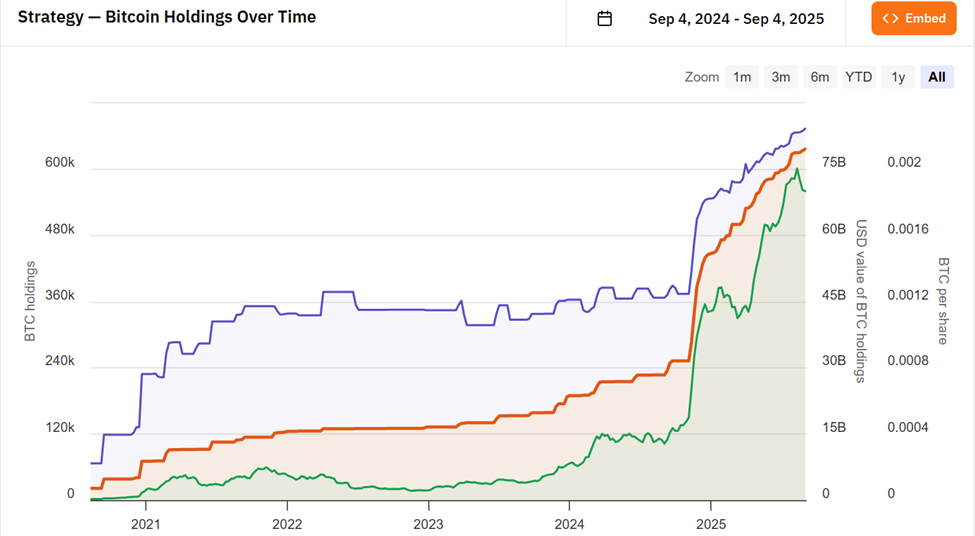Michael Saylor has built a reputation rewriting the corporate playbook. What began as MicroStrategy, a modest software firm, has morphed into Strategy, the world’s largest Bitcoin (BTC) treasury.
However, with $8.2 billion in debt, $735 million in fresh dilution, and an expanding suite of exotic financial products, critics warn Saylor is steering the company into uncharted, high-risk territory.
Debt, Dilution, and Bitcoin Exposure Put Strategy in the Hot Seat
Over the past three years, Strategy has steadily abandoned its legacy identity. Investors no longer value the firm on discounted cash flows but almost exclusively on its 636,505 BTC reserves and Saylor’s monetization ability.

The executive chair has been upfront about his mission, to build out the yield curve for Bitcoin credit through new securities such as STRK, STRF, STRD, and STRC.
This positioning makes Strategy less a traditional company and more a leveraged Bitcoin bank. Every debt issuance, equity sale, and structured product is designed to accumulate more BTC, amplifying both upside and downside exposure.
However, the latest controversy reflects that shift. On July 31, executives pledged not to dilute MSTR shares between a 1–2.5x multiple of net asset value (mNAV). That safeguard was quietly removed by August 18.
Since then, the firm has sold $735.2 million in stock squarely within that range, sparking accusations of bad faith.
“Saylor pulled the rug…This was never about Bitcoin; it’s about Saylor cashing in,” WhaleWire CEO Jacob King posted on X.
Others see the move as a classic Wall Street maneuver to preserve management flexibility at the cost of shareholder trust.
Transparency Turns to Vulnerability with Systemic Risk in the Making
Adding to the unease, blockchain analytics firm Arkham recently revealed 97% of Strategy’s Bitcoin wallets, linking nearly $60 billion in holdings to traceable addresses.
While some hail it as proof of reserves, others warn that it exposes Strategy as a single point of failure in the Bitcoin ecosystem.
“If they ever move that BTC from the wallets, expect a market collapse,” wrote one veteran trader.
The revelations have also raised concerns about operational security, with some warning Saylor himself could become a target amid rising crypto-related crimes.
The combination of debt, dilution, and transparency leaves Strategy in a fragile position. The company risks amplifying every market swing by tying shareholder value to Bitcoin’s volatility.
A sudden BTC downturn could strain debt obligations, tank MSTR’s stock, and reverberate across funds that hold it as a constituent.
Proponents argue that Saylor is playing a long game, converting fiat liabilities into Bitcoin dominance. However, critics see governance risks as dangerous concentrations of power.
“The updated MSTR Equity Guidance… could potentially hurt the company by diluting shareholder value, eroding investor confidence, putting downward pressure on the stock price, and increasing financial risk due to dependency on Bitcoin’s volatility,” one user observed.
While Michael Saylor remains undeterred, Strategy’s equity base is stretched, its debt load is heavy, and its wallets are exposed.
Based on this, the company’s fate may increasingly be entwined with the stability of the crypto market itself.
Whether seen as visionary or reckless, Michael Saylor’s experiment could turn one company into a potential systemic risk for Bitcoin.
The post Is Michael Saylor’s Bitcoin Empire Built on Dilution, Debt, and Financial Risk? appeared first on BeInCrypto.




